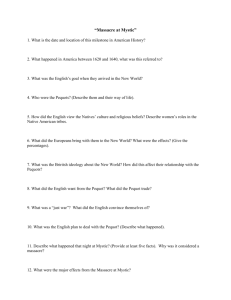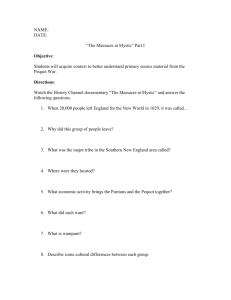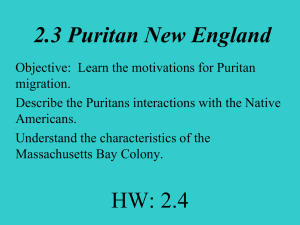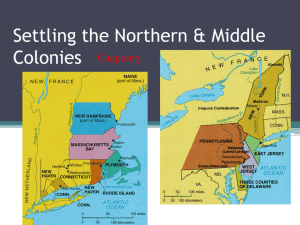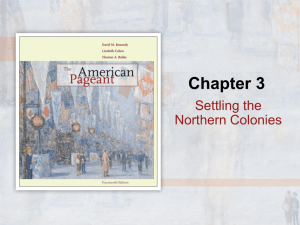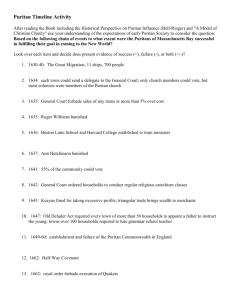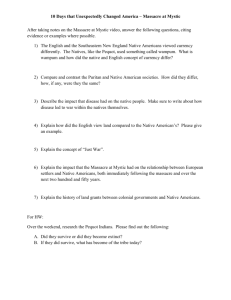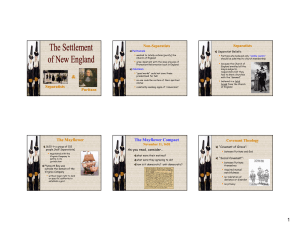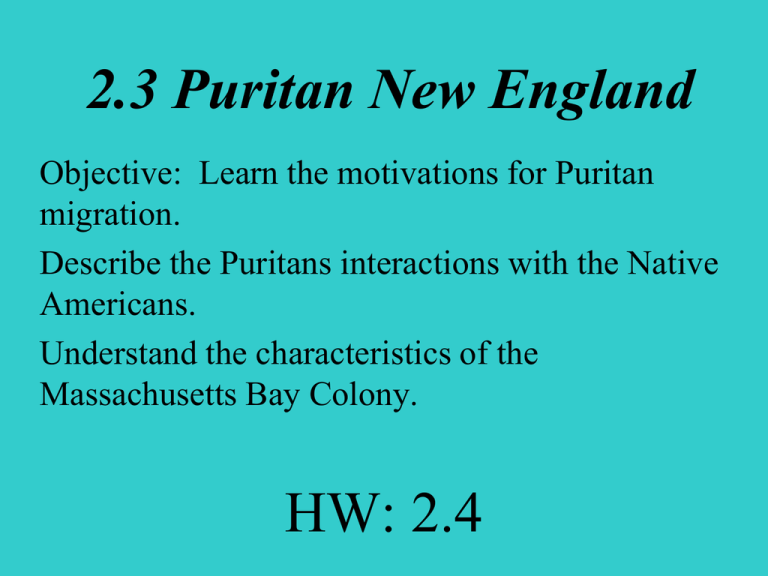
2.3 Puritan New England
Objective: Learn the motivations for Puritan
migration.
Describe the Puritans interactions with the Native
Americans.
Understand the characteristics of the
Massachusetts Bay Colony.
HW: 2.4
• Puritans want to purify Church of England
of Catholicism
• Puritan Separatists exiled by King James I; they go to
Holland
• 1620, Pilgrims (Puritan Separatists) leave Holland &
found Plymouth Bay Colony
• In northern colonies, religion, not profit, drives
colonization
• Mayflower Compact- early example moderate self govt.
• Myles Standish is their leader.
• Merged with Mass. Bay Colony in 1691
http://www.winthropsociety.org/portraits.php
Puritans create New England
Reasons for the Plantation in New England
ca. 1628
Redacted and introduced by Marcia Elaine Stewart.
# 1. It will be a service to the Church of great consequence to carry the Gospel into
those parts of the world, to help on the fullness of the coming of the Gentiles, and to
raise a bulwark against the kingdom of AnteChrist, which the Jesuits labor to rear up in
those parts.
# 2. All other Churches of Europe are brought to desolation, and our sins, for which the
Lord begins already to frown upon us and to cut us short, do threaten evil times to be
coming upon us, and who knows, but that God hath provided this place to be a refuge
for many whom he means to save out of the general calamity, and seeing the Church
hath no place left to fly into but the wilderness, what better work can there be, than to
go and provide tabernacles and food for her when she be restored.
#6. The fountains of learning and religion are so corrupted that most children (besides
the unsupportable charge of their education) are perverted, corrupted, and utterly
overthrown by the multitude of evil examples and the licentious government of those
seminaries, where men strain at gnats and swallow camels, and use all severity for
maintenance of caps and like accomplishments, but suffer all ruffianlike fashions and
disorder in manners to pass uncontrolled.
http://www.winthropsociety.org/doc_reasons.php
• 1630, as a “city on a hill” for Puritans
• Led by John Winthrop, Governor of colony
• Established an independent government for the
colony
• 2/3 of males (churched only) enfranchised
• Very large and well-stocked expedition
• Very successful, encouraged the “Great Migration”
• 20,000 migrated between 1630 and 1640
http://www.winthropsociety.org/portraits.php
Massachusetts Bay
Colony
“City upon a hill”
Protestant work ethic God rewards his elect
System of winners and losers, see Winthrop p. 54
All “freemen” could vote – very democratic at the time
Church and state were closely linked
Taxes supported the church
Laws punished both criminal and undesirable act
such as idleness and drunkenness “Blue Laws”
• Little concept of privacy – Church and State could
punish parents for poor parenting, marital problems, etc.
•
•
•
•
•
•
Excerpt: “A Model of Christian Charity”
By Governor John Winthrop, 1630
For this end, we must be knit together, in this work, as one man. We must entertain
each other in brotherly affection. … We must delight in each other; make others’
conditions our own; rejoice together, mourn together, labor and suffer together,
always having before our eyes our commission and community in the work, as
members of the same body. So shall we keep the unity of the spirit in the bond of
peace. … We shall find that the God of Israel is among us, when ten of us shall be
able to resist a thousand of our enemies; when He shall make us a praise and glory
that men shall say of succeeding plantations, "may the Lord make it like that of New
England." For we must consider that we shall be as a city upon a hill. The eyes of all
people are upon us. So that if we shall deal falsely with our God in this work we
have undertaken, and so cause Him to withdraw His present help from us, we shall
be made a story and a by-word through the world. We shall open the mouths of
enemies to speak evil of the ways of God, and all professors for God's sake. We
shall shame the faces of many of God's worthy servants, and cause their prayers to
be turned into curses upon us till we be consumed out of the good land whither we
are going.
Interior of the Old Ship Meeting House in
Hingham, Massachusetts
Interior of the Old Ship Meeting
House in Hingham, Massachusetts
The meetinghouse, or church, stood at
the center of every Puritan community in
colonial New England. Built in 1681, the
Old Ship Meeting House of Hingham,
Massachusetts, was designed to resemble
the hull of an upside down ship.
Although the Hingham church is simple
and unadorned, the placement of the
pews and their assignment to local
families based on their wealth,
background, and social standing, makes
clear that the Puritans were not radical
egalitarians like the Quakers. (Peter
Vanderwarker )
Copyright © Houghton Mifflin Company. All rights reserved.
• Anne Hutchinson, exiled in 1638.
In 1643 she and her family were killed in
a war fought between the Dutch colonists
and N. Americans
She is seen as the beginning of the
American tradition of Freedom
of Conscience.
• Roger Williams, fled MBC in 1636.
Befriended by Native Am and settled in
Narragansett Bay.
Founded Rhode Island – community
based on religious tolerance.
tp://www.rogerwilliams.org/biography.htm http://www.greatwomen.org/women.php?action=viewone&id=84
Dissent in the Puritan Community
Conflict with Native Americans
• Original co-existence w/ Native Americans Tension
• Expansion of colony leads to conflict with Pequot Nation
SEE PAGE 56
• 1637 Punitive conflict begins, Pequots are exterminated.
• Metacom, aka King Philip, resists expansion
• King Philip’s War, 1675
• Wampanoag tribe is destroyed, Metacom killed
• Was the last Native American resistance in Puritan
colonies
• Conflict is denounced by Roger Williams
Pequot War -1637
“At the time of the Pequot War, Pequot strength was concentrated along the
Pequot (now Thames) and Mystic Rivers in what is now southeastern
Connecticut. Mystic, or Missituk, was the site of the major battle of the War.
Under the leadership of Captain John Mason from Connecticut and Captain John
Underhill from Massachusetts Bay Colony, English Puritan troops, with the help
of Mohegan and Narragansett allies, burned the village and killed the estimated
400-700 Pequots inside.
The battle turned the tide against the Pequots and broke the tribe's resistance.
Many Pequots in other villages escaped and hid among other tribes, but most of
them were eventually killed or captured and given as slaves to tribes friendly to
the English. The English, supported by Uncas' Mohegans, pursued the remaining
Pequot resistors until all were either killed or captured and enslaved. After the
War, the colonists enslaved survivors and outlawed the name "Pequot.“”
– source:http://www.colonialwarsct.org/1637.htm
Colonists attack on Mystic, a Pequot village and fort
25 May 1637
English and their allies approach Sassacus's
Pequot Harbor fort. They decide to attack
fort at Mystic instead. English and allies
arrive at Mystic at night and make camp.
26 May 1637
Attack on Mystic:
English fire a volley at dawn, then storm the
fort. Mason enters at northeast, and
Underhill enters at southwest. Pequots fight
fiercely. Mason abandons plan to seek booty
and sets fire to 80 huts housing
approximately 800 people (men, women, and
children). 600-700 Pequots die in an hour. 7
are taken captive, and 7 escape. Two
Englishmen are killed, with 20-40 wounded.
English march toward their ships, burning
Pequot dwellings along the way.
SOURCE:http://www.colonialwarsct.org/1637.htm
Drawing of Mystic , a Pequot fort
http://go.hrw.com/hrw.nd/gohrw_rls1/pKeywordResults?ST9%20King%20Philip

